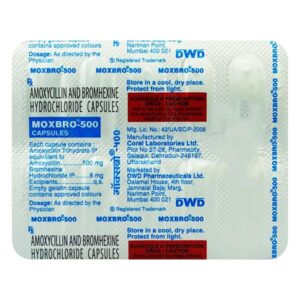AMOXYCILLIN + BROMHEXINE
Amoxycillin: Amoxicillin is a commonly used antibiotic categorized under the drug class known as penicillins. It is primarily employed to treat bacterial infections caused by susceptible organisms.
The mechanism of action of amoxicillin involves inhibiting the synthesis of bacterial cell walls. It does this by targeting and binding to the penicillin-binding proteins (PBPs), which are enzymes involved in the cross-linking of peptidoglycan chains that make up the bacterial cell wall. By inhibiting PBPs, amoxicillin interferes with the bacterial cell wall formation, thereby compromising the structural integrity of the bacteria and leading to their death.
Amoxicillin may be prescribed for various types of infections, including respiratory tract infections (such as bronchitis, pneumonia, and sinusitis), ear infections, urinary tract infections, skin infections, and certain sexually transmitted infections like gonorrhea. It is also used in combination with other medications to treat stomach ulcers caused by Helicobacter pylori infection.
The recommended dosage of amoxicillin can vary depending on the type and severity of the infection, as well as the patient’s age, weight, and renal function. It is typically taken orally as capsules, tablets, or a suspension.
Common side effects of amoxicillin include gastrointestinal disturbances such as nausea, vomiting, diarrhea, and abdominal pain. Additionally, it may cause allergic reactions ranging from mild skin rashes to severe and potentially life-threatening anaphylaxis. If any unusual side effects or allergic reactions occur, it is essential to seek medical attention promptly.
It is crucial to note that amoxicillin should only be used as directed by a healthcare professional. The dosage and duration of treatment should be followed as prescribed, even if the symptoms improve before the full course is completed. Incomplete treatment may allow the bacteria to become resistant to the medication and lead to recurrent infections.
Bromhexine: Bromhexine is a medication that is commonly used as an expectorant and mucolytic agent. It is primarily prescribed for the treatment of respiratory conditions such as coughs associated with bronchitis, asthma, and other respiratory tract infections.
The mechanism of action of Bromhexine involves increasing the production and secretion of respiratory tract fluids. It works by reducing the viscosity of mucus, making it thinner and less sticky. This action helps to facilitate the clearance of mucus from the respiratory tract, making it easier for the patient to cough up and expel phlegm.
The usual recommended dose of Bromhexine for adults is 8 to 16mg three times daily, while for children it is 4 to 8mg three times daily. The dose may vary depending on the severity of the condition and individual patient factors, so it is important to follow the instructions provided by a healthcare professional.
Some common side effects of Bromhexine may include gastrointestinal upset such as nausea, vomiting, and diarrhea. Allergic reactions such as skin rashes and itching can also occur but are rare. If any of these side effects persist or worsen, it is important to consult a doctor.
It is worth noting that Bromhexine may interact with other medications, so it is essential to inform your healthcare professional about any other drugs you are taking, including over-the-counter medications and dietary supplements, to avoid any potential drug interactions.
Overall, Bromhexine is an effective medication for managing respiratory conditions characterized by excessive mucus production. It helps to alleviate symptoms by loosening and thinning mucus, making it easier to cough up and expel from the respiratory tract.

